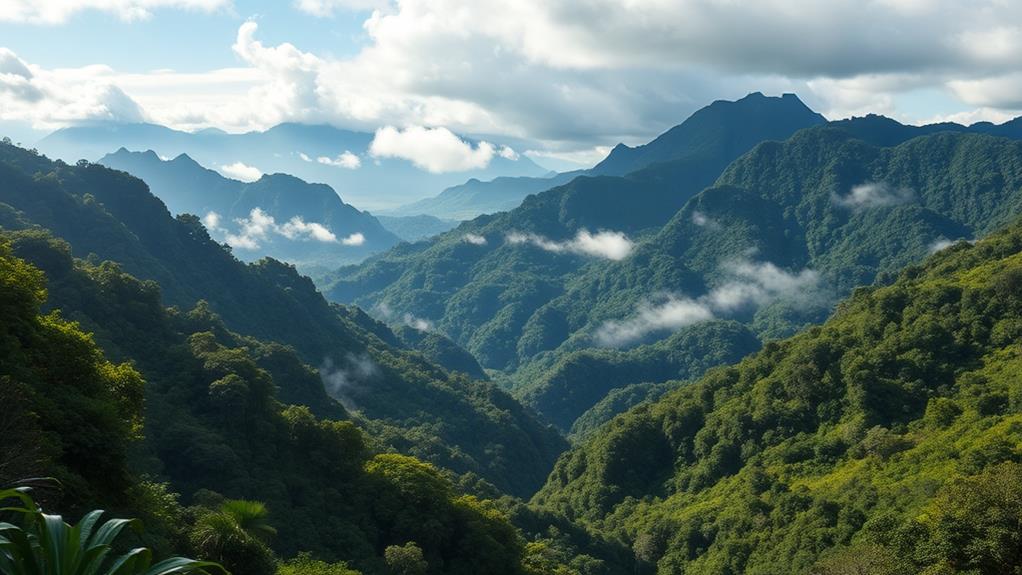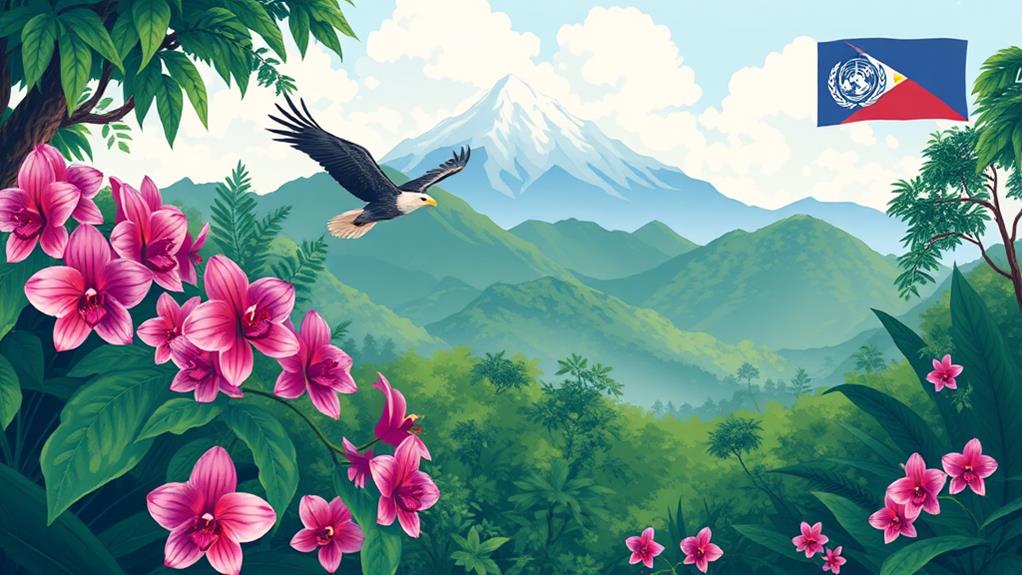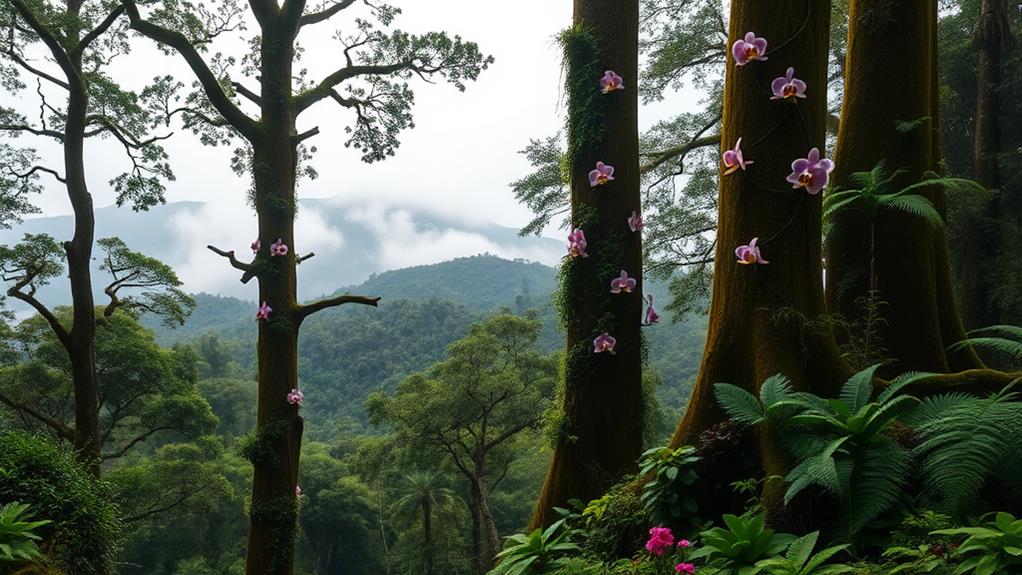Mount Kitanglad Range in Mindanao spans 47,270 hectares of diverse ecosystems.
This vast area supports over 150 plant species, including endangered and endemic species like Rafflesia schadenbergiana.
The range features six major habitat types, each vital for supporting biodiversity.
These habitats are home to a rich fauna, including the critically endangered Philippine eagle and 57 bird species.
Additionally, the range is inhabited by 11 reptile species.
Mount Kitanglad Range is a treasure trove of biodiversity due to its unique combination of ecosystems.
This ecological gem continues to reveal its secrets, making it a fascinating region to explore.
Geographic and Ecological Significance

Mount Kitanglad Range Natural Park: A Hub of Ecological Diversity
The Mount Kitanglad Range Natural Park is a vast expanse of 47,270 hectares, featuring diverse ecosystems such as agroecosystems, montane, mossy, and pygmy forests.
The park’s highest peak reaches an impressive 2,938 meters.
A Critical Watershed
This park serves as a critical watershed for Bukidnon and neighboring provinces, regulating the regional water supply essential for local agriculture and communities.
Biodiversity Hotspot
Recognized as a Key Biodiversity Area, Mount Kitanglad is home to over 150 plant species, including endangered and endemic flora like Rafflesia schadenbergiana and Tmesipteris lanceolata.
The park’s diverse habitat types support a rich variety of fauna, including:
- The critically endangered Philippine eagle
- 7 amphibians
- 57 bird species
- 11 reptiles
Ecological Significance
As one of the last remaining rainforests in the Philippines, Mount Kitanglad’s ecological significance is undeniable, making it a haven for biodiversity.
Cultural Heritage and Indigenous Communities
Mount Kitanglad Range Natural Park is a biodiversity hotspot that’s also home to a rich cultural heritage.
The park is inhabited by various indigenous tribes, including the Bukidnon, Talaandig, Higaonon, and Manobo, who maintain their ancestral domains and practice traditional customs.
These tribes perform major rituals, such as Kaliga, which focus on health, family, environmental protection, and resource utilization, reflecting their deep connection to the land.
The “Wisdom Keepers of Kitanglad” book highlights the importance of Indigenous Knowledge Systems (IKSPs) within the park, serving as a guide for cultural preservation.
Cultural zones established by the tribes within the MKRNP illustrate their spiritual and cultural ties to the region, reinforcing the significance of the area as sacred sites.
Annual celebrations like Aldaw ta Kitanglad and Anlaw ta Kalatungan honor the contributions of Indigenous communities, fostering engagement and appreciation for their cultural heritage in ecotourism.
These celebrations promote the significance of preserving the cultural heritage of the indigenous communities living in the park.
Biodiversity Conservation Efforts

Mount Kitanglad Range Natural Park: A Biodiversity Hotspot
Mount Kitanglad Range Natural Park is a Key Biodiversity Area and Important Bird Area, boasting an impressive array of species. Within the park, three nesting sites of the critically endangered Philippine Eagle have been identified.
Conservation Efforts
Conservation efforts in Mount Kitanglad Range Natural Park are strengthened by the involvement of Indigenous Political Structures and community participation. Local tribes have historically practiced forest conservation, and the revival of tribal defense systems has further enhanced protection efforts against habitat loss and degradation.
Biodiversity
Ornithological studies have documented over 198 bird species in the park, highlighting the importance of understanding regional patterns of biological diversity.
The main threats to biodiversity in the area are agricultural encroachment and habitat disturbance.
Promoting Conservation
To promote biodiversity conservation, local communities, government agencies, and environmental organizations are working together to foster sustainable tourism practices and educational programs.
Ecotourism Opportunities and Challenges
Mount Kitanglad Range Natural Park: A Biodiversity Hotspot for Ecotourists
Mount Kitanglad Range Natural Park is a prime destination for ecotourists, boasting over 198 bird species and diverse ecosystems. This biodiversity hotspot offers exciting ecotourism activities that support sustainable development.
Exciting Ecotourism Experiences
Trek to peaks like Mt. Kitanglad and Mt. Dulang-Dulang, offering breathtaking views of the surrounding landscape.
Camp at Cinchona Forest Reserve, where you can unwind amidst nature’s splendor.
Engage in bird watching and spot numerous endemic species, including the critically endangered Philippine Eagle.
Challenges of Ecotourism in MKRNP
While ecotourism in MKRNP offers many benefits, it also poses challenges.
The park’s growing popularity threatens its fragile ecosystems, and habitat disturbance caused by increased visitor activity and agricultural encroachment is a pressing concern.
Adopt responsible tourism practices to minimize your impact on the environment.
Legal Protection and International Recognition

Robust Legal Safeguards Protect Mount Kitanglad Range Natural Park
Mount Kitanglad Range Natural Park is safeguarded by robust legal safeguards to conserve its ecosystems and biodiversity.
The Republic Act 8978, or the Mt. Kitanglad Range Protected Area Act of 2000, ensures the conservation of its ecosystems and biodiversity.
International Recognition and Designations
Mount Kitanglad Range Natural Park has received international recognition and designations for its cultural and ecological significance.
It is listed as an ASEAN Heritage Park since 2009, promoting international recognition and support for its preservation.
Protected Area and Buffer Zone
As a protected area, Mount Kitanglad Range Natural Park spans 47,270 hectares, with 31,236 hectares designated as protected area and 16,034 hectares as buffer zone.
This legal status reinforces its importance for conservation.

Unique Flora and Fauna Species
Mount Kitanglad Range Natural Park is home to a diverse array of unique flora and fauna species found nowhere else on the planet.
The park’s rich biodiversity is reflected in its unique assemblage of plant and animal species. The critically endangered Rafflesia schadenbergiana and Tmesipteris lanceolata are notable examples, known for their unique characteristics.
The park is also home to the Philippine brown deer and the Mindanao pygmy fruit bat, which contribute to the park’s rich biodiversity. These species are a testament to the park’s importance as a haven for biodiversity in Mindanao.
Mount Kitanglad is home to the critically endangered Philippine Eagle and several endemic bird species, including the Mindanao racquet-tail and Mindanao lorikeet.
However, habitat disturbance from agricultural practices poses significant threats to the survival of many endemic and endangered species.
To protect Mount Kitanglad’s unique ecosystems and the incredible flora and fauna that call it home, conservation efforts are crucial.
Habitat Types and Ecological Niches

Mount Kitanglad Range Natural Park’s diverse landscape comprises six major habitat types, each playing a vital role in supporting the park’s extraordinary biodiversity.
Habitat Types and Ecological Significance
| Habitat Type | Characteristics | Ecological Significance |
|---|---|---|
| Lowland Evergreen Forest | Species-rich, diverse flora and fauna | Supports unique endemic species |
| Montane and Mossy Forest | Distinct microhabitats, complex structure | Fosters ecological niches for conservation |
| Freshwater Wetlands | Critical ecological functions, regional hydrology | Supports bird species, maintains water cycles |
Each habitat type has a unique role in maintaining the park’s biodiversity. The lowland evergreen forest is the most species-rich, with a diverse range of flora and fauna. The montane and mossy forests are characterized by distinct microhabitats and a complex structure, providing a variety of ecological niches for conservation. Freshwater wetlands provide critical ecological functions, supporting various bird species and regional hydrology.
The park’s diverse topography and soil composition, primarily weathered volcanic ash, foster a unique combination of habitats essential for the conservation of endemic species like the Philippine Eagle.
What Biodiversity Can be Found Along the Cagayan River?
Cruising along cagayan river in philippines offers a glimpse of diverse biodiversity. The river is home to various fish species like catfish, carp, and tilapia. Its banks are rich with lush vegetation, hosting a variety of bird species such as herons, egrets, and kingfishers. The river is teeming with life.
Community Engagement and Sustainable Tourism
Community Engagement is Crucial for Preserving Biodiversity
As the Mount Kitanglad Range Natural Park works to preserve its rich biodiversity, community engagement plays a vital role in this effort. The park’s conservation relies heavily on the active participation of Indigenous Cultural Communities through the Protected Area Management Board (PAMB). This collaboration ensures that traditional customs and practices are respected and preserved, promoting a harmonious relationship between nature and culture.
Fostering Community Engagement
Annual Celebrations Promote Indigenous Contributions: Annual celebrations like Aldaw ta Kitanglad and Anlaw ta Kalatungan highlight Indigenous contributions and encourage local involvement in sustainable tourism practices.
Ecotourism Activities Benefit Local Communities: Ecotourism activities, such as trekking and bird watching, provide economic benefits to local communities and foster appreciation for the rich biodiversity and cultural heritage of the area.
Respecting Traditional Practices: The integration of Indigenous Knowledge Systems (IKSPs) into conservation strategies ensures that traditional practices are respected and preserved.
Frequently Asked Questions
What Animals Are in Mount Kitanglad?
Mount Kitanglad is home to a diverse range of wildlife. The Philippine brown deer and unique bat species are among the rare mammals found in the park.
The park’s avian diversity is equally impressive, with 198 bird species, including 17 endemic species.
Additionally, the park is home to seven amphibian species and 11 reptile species, highlighting its ecological significance.
The habitat protection efforts are crucial for wildlife conservation, as the animal adaptations rely on the forest’s ecological niches.
This is particularly important in Mindanao, where biodiversity is rich but conservation challenges remain a pressing concern.
What Is the Biodiversity of Mount Kalatungan?
Mount Kalatungan is home to a diverse range of ecosystems, which support a wide variety of endemic species. The mountain’s flora diversity is particularly notable, with rare species like Rafflesia schadenbergiana, a type of parasitic plant, found only in this region.
Conservation efforts focus on preserving this unique flora and mitigating the impact of climate change on delicate wildlife habitats.
Trekking routes on Mount Kalatungan offer a glimpse into the ecological significance of this haven. However, environmental threats loom large, making research initiatives crucial to protecting this vital watershed and its unique fauna.
In order to preserve this biodiversity hotspot, it’s essential to conduct research and implement conservation measures to safeguard the mountain’s ecosystems and species.
What Is There to Do in Mount Kitanglad?
Experience the Great Outdoors in Mount Kitanglad
Mount Kitanglad offers a variety of exciting activities for adventure-seekers and nature lovers. Hiking trails lead to stunning peaks, providing breathtaking views and opportunities to explore the area’s diverse flora.
Bird enthusiasts can spot over 198 species recorded in the area, making it a bird watcher’s paradise.
Capture Nature’s Beauty
Photography enthusiasts can capture the beauty of nature through their lenses, while camping spots provide a chance to unwind and connect with nature.
Immerse in Local Culture
Visitors can savor local cuisine and immerse themselves in cultural experiences, learning about the region’s rich heritage.
Guided tours promote environmental conservation, educating participants about the importance of preserving the area’s natural resources.
End the Day with a Celestial Show
As the day comes to a close, star gazing in the peaceful surroundings provides a serene and memorable experience.